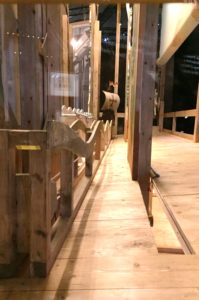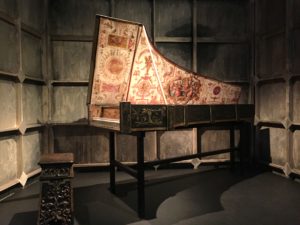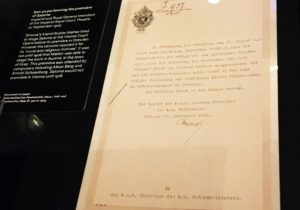The model of a Baroque box stage makes a staggering impression: meticulously reproduced at almost 1:1 scale, with a beautifully-painted proscenium, side decorations hidden in the wings and a few rows of wooden waves on the stage. Everyone cranes their neck to get a look at the immobilized elements of theatrical machinery. Having heard a delicate grinding noise, the viewers take a step back. The blocks begin to turn. A caravel hidden at the rear of the stage sails out onto the rolling wooden sea. A little closer to the proscenium, two sirens are playing in the waves. Their seductive soprano song is also heard from the earphones that visitors received at the entrance. The sound track has neither beginning nor end: the sensors installed in the transmitter localize the exhibits being viewed and play opera fragments associated with them. In this case, the beginning of Act II of Händel’s Rinaldo, in which the title character falls into the sirens’ trap. The guests return to the model several times each, crowding before it like children after a puppet show. The creaky noises of the blocks and winches echo all over the gallery.
Perhaps 15 or so meters further, yet another wonder, particularly meaningful to viewers who have never sung in a choir. On a wall bent into a half-circle, 150 photographs by Matthias Schaller, creator of the famous Disportraits. Each photo presents the auditorium of a different Italian opera house. In our earphones, we hear the song of the Jewish exiles from Verdi’s Nabucco, played in the form of a suggestive acoustic installation. Sound engineer David Sheppard provided the choristers of the Royal Opera House with separate microphones, so that the listener has the illusion of finding themselves among the crowd of singers onstage. I uncover my ears for a moment. Everyone around me is crooning ‘Va, pensiero, sull’ali dorate’ – probably not realizing that viewers standing nearby can hear them.
Photo: Dorota Kozińska.
Even just for these two installations, it is worthwhile to visit the Opera: Passion, Power & Politics exhibition that opened on 30 September at the Victoria & Albert Museum in London. However, the overwhelming power of this exhibition, organized in collaboration with the opera at Covent Garden, lies elsewhere. It is not just a tale of the history of the form, now over 400 years old: it is an attempt to place it in the context of the history of transformations in politics, society and mores in Europe; and in a more distant perspective, an attempt to give a solid answer to the question of what its future will be in a world globalizing at lightning speed. The idea to organize the exhibition was born five years ago during a meeting of Kate Bailey, the newly-hired curator in the V&A’s Department of Theatre and Performance; Danish stage director Kasper Holten, the freshly-appointed director of the Royal Opera House; and Martin Roth, at the time director of the museum, who resigned his post before term, in 2016, as a protest against the results of the referendum on the United Kingdom’s membership in the European Union. The initiative was brought to fruition thanks to the determination of Bailey and Holten – the latter of whom, by the way, left the London opera in March, having rejected an offer to extend his contract. Roth died prematurely at age 62, less than two months before the exhibition opening: after a short and severe illness that doctors diagnosed shortly after he submitted his resignation from his post at the V&A.
The curator and the opera director were united in their vision to organize a so-called performance exhibition that would draw the viewer into a scrupulously-arranged space and give him or her a feeling of participation in this peculiar show. The museum director turned out to be the brains of the endeavour: having gotten his doctorate in Tübingen with a dissertation on museology and the art of exhibition in imperial Germany, the Weimar Republic and the Third Reich, he had spent his entire life afterward studying the historical and political conditions of art reception. Bailey proposed the framework for the exhibition: to show the complicated fortunes of Europe through the prism of seven opera premières in seven cities. The choice turned out to be difficult and could appear surprising to many music lovers, all the more so that Orfeo was missing – after all, the première of Monteverdi’s masterpiece at the Gonzaga court in Mantua on 24 February 1607 is considered the symbolic birth date of the opera genre. However, this was intentional on the part of the organizers: to begin the narrative at a moment when the new form had left the palaces of the aristocracy and entered into public space. And it did so faster than expected, even within the lifetime of the composer, who acquired the appellation of its founding father.
Photo: Dorota Kozińska.
Over 300 exhibits, including installations, sound materials and video recordings, were gathered in the newly-opened Sainsbury Gallery – an underground gallery comprising part of the visionary Exhibition Road Quarter establishment, executed with panache by the young London design office of Amanda Levete Architects. Visitors wander in semi-darkness through an enormous space covering over 1000 m2 in surface area, moving fluidly from era to era, from one aesthetic to another, from the city where the first gamblers’ den opened to the former capital of a certain empire that to this day carries on a dangerous game with the world’s fortunes.
The tale begins in Venice in 1642 at the Teatro Santi Giovanni e Paolo, with the première of L’incoronazione di Poppea – one of the first operas based on historical events, featuring characters of flesh and blood, which continue to speak to the imagination and sensitivity of a culturally-inclined European. In each object on display lurks an ambiguity similar to that in Monteverdi’s morally ‘uncertain’ opera. Richly-adorned zoccoli, footwear on high wooden platforms, served both humble Venetian wives, protecting their feet from the waste matter of Venetian backstreets, and Venetian courtesans, who lured their customers with simulated height, hiding imperfections in their figure beneath the folds of richly ornamented gowns. The shapes of hand-blown glassware bring to mind equally sensual associations as the bluntly literal portrait of composer Barbara Strozzi, painted with viola da gamba in hand and voluptuous, flirtatiously exposed bust line. From Venice, we move to London at the beginning of the 18th century, to the city where the whole world’s trade routes intersected, where Italian opera – thanks to the genius of Händel – was gaining an entirely new dimension reflected in, among other things, the engravings of Hogarth, who masterfully conveyed the transient triumph of castrato singing and brilliant stage machinery over the tradition of Shakespearean theatre and the legacy of other English authors. The circumstances of the Vienna première of Mozart’s Le nozze di Figaro in 1786 make viewers aware that the outbreak of the French Revolution was rather a failure than a fulfillment of European Enlightenment ideals. Milan – shown on the example of Nabucco, the early Verdi opera that brought him real fame, performed for the first time in 1842 at the Teatro alla Scala in that city – is revealed to the be composer’s destiny, a city which during the Risorgimento traveled a road as long and bumpy as that traveled by Verdi himself, and finally, 60 years after the première, escorted his remains on their final road to the Casa di Riposo to the sounds of ‘Va, pensiero’ under the baton of the young Toscanini. Hidden behind the calamity of Wagner’s Tannhäuser in Paris in 1861 is the story of the great renovation of the capital by Georges Haussmann. Richard Strauss’ Modernist opera would not have resulted in a wave of mad ‘Salomania’ if Salome’s première in 1905 had taken place anywhere besides Dresden – a bastion of European Expressionism. The convoluted fortunes of Shostakovich’s Lady Macbeth of Mtsensk – presented with enormous success at the Mikhailovsky Theatre in Leningrad in 1934, and crushed two years later, during the Great Purge, when Stalin demonstratively left the show at Moscow’s Bolshoi Theatre after Act III – are one of the clearer illustrations of the havoc wreaked by censorship in totalitarian states.
Photo Dorota Kozińska.
The stupefied viewers move on to the next room, where they can sit down for a moment and immerse themselves in the sounds of 20th-century and contemporary operas: from Gershwin’s Porgy and Bess to George Benjamin’s Written on Skin and Kaija Saariaho’s L’Amour de loin. I don’t know how other visitors found their place in this acoustic landscape – I had the impression that the operatic masterpieces from after World War II revolved obsessively around the theme of aggression and violence. I am just as pained by the whistle of the guillotine in the final scene of Poulenc’s Dialogues des Carmélites, as by the cries of the drowned boys from Britten’s Peter Grimes and the percussive machine gun salvos in John Adams’ The Death of Klinghoffer, an opera based on the dramatic events that played out in October 1985 on the deck of the MS Achille Lauro, hijacked by Palestinian terrorists.
But after all, opera – that most genuine, with a large orchestra, choir and a host of soloists – is still a living form and speaks to the deepest layers of human emotion. In Poland, a country with a tenuous tradition in this art form, directors obstinately try to convince us that that is not the case, that the only alternative is to ‘resurrect’ past masterpieces through theatrical directing, or seeking out new means of expression in compositions from the intersection between performance art, sound installation and visual theatre. All the greater impression is made by the statements of critics, theorists and artists collected in the London museum’s exhibition catalogue. People who are thinking about the position of opera in the development of contemporary cities make reflective conjectures about the role that the creators and audiences of today’s shows should play in this work. They repeat ad infinitum that listeners should be acquainted with this art form from childhood, and if it happens that parents or teachers have neglected their education in their youth, then just keep making the effort. Drag stone-deaf friends to the theatre, convince politicians to opera who are stuck in a mistaken conviction that they are dealing with an elite variety of art inaccessible to the listener. But above all – continually deepen their knowledge, listen, respond, focus on what is happening onstage, absorb the music with an open mind.
There are those who can do that. Evidence of this is the short essays preceding the more thorough discussions of the individual segments of the exhibition in the catalogue. The shaping of the character of Poppea is discussed in a lively and zestful manner by Australian soprano Danielle de Niese; the building of bridges between 18th-century and contemporary audiences, by Robert Carsen, stage director of the production of Rinaldo for the Glyndebourne festival in 2011; the intricacies of the score to Mozart’s Le nozze di Figaro, by ROH music director Antonio Pappano, who directed their production in 2012; why a tenor idol of the world’s stages decided in his elderly age to take on the part of Nabucco, by Plácido Domingo; the corporeality of Tannhäuser, by stage designer Michael Levine; the traps of feminism in the interpretation of Salome, by conductor Simone Young; and the darkest corners of the feminine soul, by Graham Vick, stage director for two productions of Shostakovich’s Lady Macbeth.
I viewed the London exhibition with a growing sense that I am sometimes the Columbus, sometimes the Cassandra of Polish opera criticism. For years, I have been discovering stage directors, conductors and singers unknown in our country. For years, I have been crying, like Priam’s daughter, that opera theatre in Poland – despite appearances – stinks of naphthalene; despite its supposed avant-garde character, it constantly duplicates the same patterns, becoming obnoxiously bourgeois in the hope of applause from the indolent West. I was filled with all the greater joy by the words of Yuval Sharon, an American stage director and freshly-baked winner of a MacArthur Fellowship who opposes the plague of operatic co-productions, clearly emphasizing that this art form should be set in a peculiar context and speak to the listener in an understandable language that reaches to the very depths of the soul.
Because that is what this oddest of arts is like – it either strikes one to the very heart, or it is like water off a duck’s back. We left the exhibition at the Victoria & Albert Museum in a state of near rapture. Young and old, experts and novices. Rumors of the death of opera appear to be greatly exaggerated.
Translated by: Karol Thornton-Remiszewski



